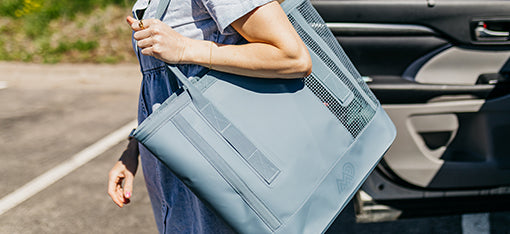How To Drive Your Inboard Boat For Wakesurfing
Driving the boat is a big responsibility. You need to know the rules on your chosen body of water, you need to be on the lookout for other boaters and possible hazards, and you need to give your passengers a safe, smooth ride. But when you toss in a few thousand pounds of ballast, waves, the DELTA 2.0 wake shaper, and a surfer behind you, it can feel pretty overwhelming.
It’s all good, though! We’re here to help you feel comfortable captaining the ship so you can enjoy your day on the water.
Weighting Your Boat with Ballast
Direct Drive Boats
If your boat has a direct drive setup, the engine will be near the middle of the boat, so you’ll want to add ballast in the back (stern) of the boat to dig the back end of the boat further into the water. But make sure you evenly weight the boat left to right (port/starboard).
V-drive Boats
With v-drive boats, the engine is near the back (stern) of the boat, so you will want to add weight in three places. Add more weight in the rear lockers to increase the height of the wave and then add more weight in the bow to increase the surfable length.
The amount of weight you’ll need to use for your ballast will vary based on your boat and how many passengers you have. Start light and keep tweaking things to find what works for you. Remember that friends and family make excellent, if sometimes stubborn, ballasts – just be sure to keep the rub rail above the water and never exceed your boat’s maximum weight capacity.
Steering Your Boat with Ballast and a Wake Shaper
If you haven’t taken the time to get used to how your boat steers and performs under normal conditions, you should definitely do that before taking on the responsibility of driving the boat for a wakesurfer. Go ahead; we’ll wait...
Welcome back. Now that you’re comfortable driving your boat with a standard setup let’s talk about driving it while loaded down with ballast and DELTA 2.0 wake shaper. Your boat is definitely going to handle differently with all these new elements. It’ll take longer to accelerate, stop, and turn because of all the added weight.
The good news is, using a DELTA 2.0 wake shaper eliminates the need to have your boat leaning heavily to one side to create a surfable wave. This not only makes your boat more manageable to drive but means you don't have to be on the lookout for rogue waves that might swamp your boat.
Speed
Learning how to accelerate and maintain your boat’s speed safely is essential for helping surfers get up on their board and remain in the pocket for as long as possible. Everyone has their preference, but the general range is 10-12.5 MPH depending on the size and skill of the rider, board style, ballast setup, and speedometer calibration.
Pulling a Wakesurfer
Start with the surfer in the water directly behind the boat. Once the rider is ready, with their feet on the board, put your boat into gear and let it idle until the rope becomes tight, this will allow the rider to get ready.
On the rider's signal, engage the throttle and gradually build toward surf speed. Keep an eye on the surfer to gauge whether you need to speed up or slow down. The right speed and acceleration will be different for kids and adults, so don’t worry if it takes a few tries to get it right.
While you really can’t accelerate too slowly, you can absolutely accelerate too quickly! Worst case scenario of accelerating too slowly: the rider doesn’t have enough speed to get out of the water. Worst case scenario of accelerating too quickly: somebody gets hurt.
Prime surf speed is somewhere between 10-12.5 MPH depending on the boat, surfer, and board.
Watch: How to Get a Great Wake Surf Wave
Picking up a Downed Surfer
Whether they fall, get tired, or just want to give someone else a turn – it definitely won’t be because of your stellar driving skills – your surfer will go down eventually, and you’ll need to turn around to pick them up. The most important thing to keep in mind is that you don’t slow down too quickly. If you just kill the throttle, you might bring water over the back (transom) of the boat.
After you slow down, give your boat a quick tap of reverse to bring it to a total stop and wait for the wake to die down on both sides. Once the water is calm, you can turn around. Just remember to turn TOWARD your wake shaper for a faster, tighter turn. When you approach the surfer, keep them on the right-hand side of the boat so that you can see them the whole time. Once you’re close enough, put your boat in neutral and turn off the engine so they can get out of the water safely and a new surfer can jump in.
Safety First
It’s all fun in the sun until someone gets hurt or does something less than smart. That’s why you should always practice proper boat safety by making sure everyone has a life jacket, passengers and weight is distributed safely around the boat, and you have either a spotter or set of mirrors to keep an eye on your surfer.
Bonus Tip
To build your confidence as a driver, you can practice rider pickups all by yourself using the "Life Jacket Hack." Just toss a spare life jacket overboard at surf speed to mimic a downed surfer, then work on your turnarounds and rider pickups at your own pace and without any pressure.


































